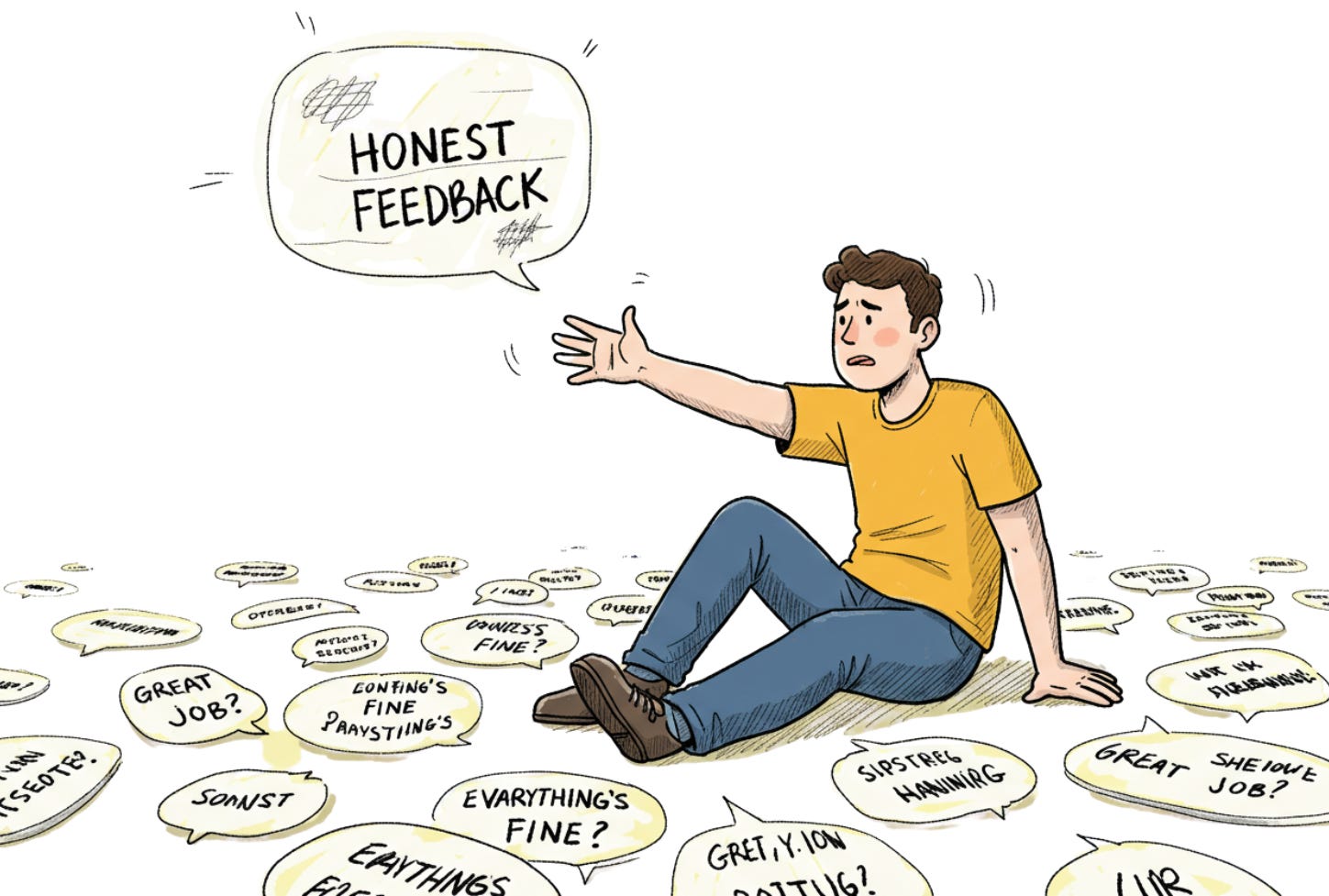Welcome to the 🔥 free edition 🔥 of Winning Strategy: a newsletter focused on enhancing product, process, team, and career performance. This newsletter shares insights gained from real-world experiences that I gathered working at Twitter, Amazon, and now as an Executive Product Coach at one of North America's largest banks. If you’d like to become a paid member, see the benefits here, and feel free to use this expense template to ask your manager.
Quick question:
When was the last time someone told you that your Retrospective technique needs work?
Or that your impediment resolution approach is too passive?
Or that your Sprint Planning facilitation could be more focused?
Can't remember? I'm not surprised.
As a Scrum Master, it often feels like you're drowning in a pool of "everything's fine" and at times, complete silence for feedback while you strive to determine if you're truly making an impact... and whether you are growing in your role.
It's ridiculous, really.
You spend your days:
helping teams have difficult conversations
teaching others how to give constructive feedback
creating safe spaces for honest communication
Yet somehow, you're stuck in the feedback torture.
your team avoids criticizing you
your Product Owner dodges performance discussions
your peers offer only superficial praise
And as a result…
You're left guessing whether you're truly effective or just really good at making people comfortable enough to avoid difficult conversations.
The IRONY?
You know exactly what good feedback looks like; you facilitate it daily.
You just can't seem to get it for yourself.
Let's fix that.
If you’re new, here’s what you missed in the last few weeks
Why do Scrum Masters struggle to get honest feedback?
Let’s face it, getting genuine, constructive feedback is an uphill battle for Scrum Masters.
Not because your team doesn’t care or because you’re bad at your role.
NO!
Because the psychology of your position works against you.
Here’s what I mean:
You’re seen as a neutral party.
You’re not the boss. You’re not subordinate. You’re Switzerland. People don’t feel like they owe you feedback, positive or negativeYou’re the “nice one.”
You’re the person who listens, supports, and helps solve problems. Giving feedback to someone who’s always helping? Awkward.Your impact is subtle.
Scrum Masters don’t deliver code. They don’t set priorities. Your influence is invisible, so people struggle to measure your effectivenessPeople fear breaking the balance.
You’ve built trust. You’ve created psychological safety. Many team members worry that giving you feedback could disrupt that balance
And therefore you get:
Silence!
Surface-level compliments!
And a lot of “you’re great, keep doing what you’re doing!”
Which, let’s face it, isn’t helpful.
For the persistent ones:
Here are 6 research-based methods to extract valuable feedback from your team.
Method #1: Ask About Specific Situations, Not General Feedback
What do you think of the following question:
"How am I doing as a Scrum Master?"
Here’s what I think: It’s a terrible question guaranteed to get you nowhere.
Why?
Because it's too big, too vague, and frankly, too intimidating for most team members to answer honestly.
Here are some popular responses to this question:
"You're doing great!"
"Everything's fine!"
Silence and crickets
So, stop asking the general question.
What you need to do is ZOOM IN on specific MOMENTS.
Try these:
"What could we improve about how I handled yesterday's impediment with the testing environment?"
"During last week's refinement, did the visualization technique help or hinder your understanding?"
"Was there anything I could have done differently when the conflict between Dev and QA emerged?"
Then, go one step deeper:
“What would you change if we faced the same situation again?”
“Was there something I could have done to make it easier for you?”
What’s the difference?
You're not asking them to evaluate YOU. You're asking them to evaluate a MOMENT.
It's safer. It's concrete. And it's actionable.
Humans are wired to recall and analyze specific events far better than they can provide general evaluations. You're essentially hacking their brains to give you what you need.
Thing to remember: Specific questions get specific answers. And specific answers are the only ones you need.
Method #2: Share Your Own Weaknesses First
Want to make people comfortable giving you the HONEST feedback?
Start by being honest about your flaws.
Drop the "Perfect Scrum Master" mask
Admit your struggles
Get vulnerable
Yes, I know...it’s a little difficult. Be genuine, though. Don’t make up stuff.
You can try these:
"I noticed I tend to talk too much in refinement sessions..."
"Sometimes I get impatient when issues aren't resolved quickly..."
"I probably overdid it with the sticky notes in that last retro..."
This shows your team you’re not just fishing for compliments, you’re genuinely looking to improve.
You're not the "feedback expert" anymore. You're just another human.
People LOVE helping humans who admit they're not perfect.
Be as specific as you can, like:
"Remember that planning session where I kept interrupting?"
"You know how I got defensive about that Kanban suggestion?"
"That retro where I pushed too hard for answers?"
Not like:
"I'm not perfect..."
"I make mistakes..."
"I have things to work on..."
Too vague. Too safe. Too useless.
Method #3: "What’s One Thing?" Questions
When it comes to feedback, less is more.
Big, open-ended questions like “What can I do better?” can overwhelm people. They don’t know where to start, so they just… don’t.
So shrink the ask.
The "What's One Thing?" technique is brilliantly simple: It limits the scope to make answering manageable.
For example, instead of this:
"How can I improve as a Scrum Master?"
Try this:
“What’s one small thing I could do differently to make your work easier?”
“What’s one thing I could stop doing that might help our team?”
“What’s one thing you wish I did more often?”
You're not asking for a comprehensive evaluation of your professional identity. You're asking for a single, specific adjustment.
These questions are simple.
They lower the pressure, making it easier for your team members to give you actionable feedback.
One thing? Anyone can think of one thing.
Method #4: Future Pacing
Here's a psychological trick for extracting the HONEST feedback:
Don't ask about the past. Ask about the future.
Why?
Because:
Past = Criticism
Future = Helping
Future pacing is a psychological technique that moves the conversation from backward criticism to forward improvement. And it works wonders for Scrum Masters seeking honest feedback.
Here’s how to do it. First say:
"In our next Sprint Planning..."
"When we run the next big retro..."
"For future impediments..."
Then add:
"...what could I do differently to make it better?"
None of these questions requires anyone to criticize what you've already done. They don't have to say "you messed up.” They have to imagine a better future.
And…
While they're describing what could be better next time, they're actually telling you what wasn't working before. You're getting the feedback you need, just packaged in a way easier for them to deliver.
Method #5: Use Team Feedback as a Starting Point
Direct questions about your performance can make team members uncomfortable.
So don't make it about you... at first.
Start with the team as your focus, then gradually zoom in.
Begin by asking broader questions:
"What habits do you think our team has fallen into that might be holding us back?"
"If you could change one practice about how our Scrum events run, what would it be?"
"What's something our team consistently struggles with during Sprint execution?"
These questions are about "us," not "you."
Team members can speak freely because they're diagnosing the system, not evaluating a person.
Once this conversation is flowing naturally, you PIVOT…slightly:
"And for me specifically, as your Scrum Master, what's one thing I could do differently to help address these team challenges?"
"How might I better support the team in overcoming that obstacle we just discussed?"
By starting with a focus on the team, you create a safe space for discussion. Then, when the moment is right, you shift the focus to yourself without making it feel intimidating.
You create a bridge from team feedback to personal feedback.
This progression feels natural.
And the result?
Honest, actionable feedback without putting anyone on the spot.
Method #6: Layered Feedback
This method creates a step-by-step path to honest communication.
Just like peeling an onion, you start with the outer, safest layers before reaching the core:
Here’s how to do it:
Start broad, then gradually get more specific:
Layer 1: Begin with an open question:
“How do you think things are going overall?”
Layer 2: Move to team-level feedback:
“What could we do better as a team?”
Layer 3: Transition to personal feedback:
“What’s something I could do differently to support you better?”
Layer 4: End with a specific example:
"In yesterday's refinement session, was there anything I could have done differently when facilitating the estimation discussion?"
This technique works because:
It creates a psychological momentum. Once someone starts providing feedback, they're more likely to continue
It establishes a feedback-friendly context before asking the harder questions
It gives the person time to organize their thoughts
It feels natural
People feel SAFE in this approach.
And when people feel safe? That’s when the best insights surface.
Got an urgent question?
Get a quick answer by joining the subscriber chat below.
Only available to Paid Subscribers.
When Is the Right Time to Ask for Feedback?
Timing is everything when it comes to feedback.
Choose the right moment, and you’ll get thoughtful, honest insights. Ask at the wrong time, and you might get hesitation or worse, silence.
Avoid these times:
Right after a crisis. When the team is recovering from a production issue or missed deadline, they're in survival mode. Their feedback will be more negative and reactive rather than thoughtful
During high-stress periods. If your developers are racing to finish a Sprint or preparing for a major demo, your request for feedback becomes one more demand on their limited bandwidth. Check out the post — Why Developers Hate Scrum And How To Fix It?
In large group settings. Few people will offer honest criticism when surrounded by peers. The social risk is too high
Look for these times:
After small wins. Following a successful Sprint or release, team members are more receptive
During 1:1s. Private conversations remove the audience effect and create space for vulnerability on both sides
At natural transition points. Sprint Retrospectives, quarterly reviews, or project completions are natural moments of reflection when people are already in an evaluative mindset
When you've demonstrated change. After you've visibly implemented previous feedback, people are more motivated to offer new insights because they see you actually use them
During moments of connection. Sometimes the best feedback comes during unplanned interactions like a coffee break after a meeting, when defenses are down
Also, remember that different team members may have different optimal timings. Some may need time to process and may prefer sending thoughts after reflection. Others may speak honestly in the moment.
It’s a human thing. We’re all humans.
The Journey Forward
Asking for feedback isn’t easy, but it’s one of the most powerful ways to grow in your role.
As you implement these six methods, remember to start small.
Choose one technique that resonates with you and try it. Notice what happens not just in the responses you receive, but in how the energy shifts between you and your team.
Over time, you'll notice that as seeking feedback becomes your habit, giving feedback becomes their habit. The feedback conversations will begin happening naturally.
And it all begins with you having the courage to ask yourself: "How can I be better?"
So take that first step.
Show your support
Every post on Winning Strategy takes 3 days of research and 1 full day of writing. You can show your support with small gestures.
Liked this post? Make sure to 💙 click the like button.
Feedback or addition? Make sure to 💬 comment.
Know someone who would find this helpful? Make sure to recommend it.
I strongly recommend that you download and use the Substack app. This will allow you to access our community chat, where you can get your questions answered and your doubts cleared promptly.
Research
https://support.cultureamp.com/en/articles/7048450-the-science-behind-team-feedback
https://www.frontiersin.org/journals/psychology/articles/10.3389/fpsyg.2022.938699/full
https://reachinbox.ai/blog/professional-feedback-request-email-template/
https://pmc.ncbi.nlm.nih.gov/articles/PMC9355701/
https://www.betterup.com/blog/how-to-ask-for-and-receive-feedback
https://pmc.ncbi.nlm.nih.gov/articles/PMC7304587/
https://www.skillpacks.com/how-to-request-feedback-from-coworkers/
https://www.gallup.com/workplace/357764/fast-feedback-fuels-performance.aspx
Further Reading
Connect With Me
Winning Strategy provides insights from my experiences at Twitter, Amazon, and my current role as an Executive Product Coach at one of North America's largest banks.














Hi Vibhor, How to handle a situation where team mates rely on scrum master for everything? is it normal?
Absolutely brilliant! Very good insight! I face this issue. Thank you!